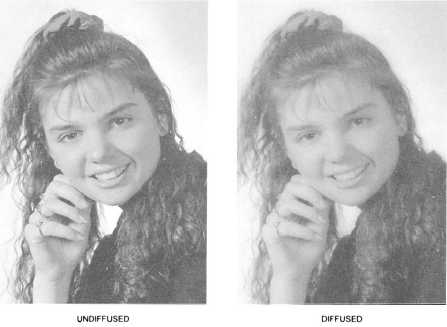PHC Carl Hinkle
302.309
Some areas of a negative that may require burning
in are the dense areas that would otherwise reproduce as
pure white with little or no detail or very light gray in
the print; for example, a bright sky, a white uniform, a
white cake, or highlights on a face.
Like dodging, to prevent an outline of the tool from
reproducing, you should keep the tool in constant
motion during the burning-in exposure.
Vignetting
In printing, vignetting is a technique that causes the
image to fade gradually into the background toward the
corners of the print. A vignette effect is produced by
projecting the desired negative image area through a
large hole cut in a piece of cardboard or by dodging the
central image area during part of the exposure time.
When the background is to be printed light, the entire
exposure should be made through the vignetting card.
When the edges of the hole are serrated, the outline of
the vignette will be soft and diffused In most cases, a
soft, diffused vignette produces the most pleasing result.
Head-and-shoulders portraits are usually the most
suitable for vignetting, although vignetting may be
applied to other subjects (fig. 11-15). A photograph with
a light background provides the most pleasing vignette
results. For a head-and-shoulders portrait, the vignetting
card should have an egg-shaped hole cut in it. The
subject in a vignette should be a little smaller than it is
in a straight nonvignetted print. Leave plenty of space
around the image. Balance the head-and-shoulders
image on the paper by leaving more blank paper below
the image than above it. The blank paper at the sides
should be about equal, but less than at the top. As with
dodging and burning in, the vignetting card must be kept
moving during the exposure.
Diffusing
Photographs can be diffused so sharp lines of the
image are softened, subdued, or blurred slightly in the
reproduction. Diffusion can be used to produce a hazy
effect, such as the effect seen on a warm lake in early
morning. In printing portrait negatives, diffusion can be
used to subdue the reproduction of facial blemishes or
wrinkles. The effects of harsh portrait lighting or
retouching also may be softened with diffusion (fig.
11-16).
The best diffused enlargements are made using a
glass diffusing disk placed under the lens of the enlarger.
Other suitable diffusing materials are transparent
cellophane, either smooth or wrinkled, or a piece of
panty hose, or similar fabric. Dark gray or black is
preferable.
Figure 11-16.–Head-and-shoulders portrait using diffusing techniques.
11-19

